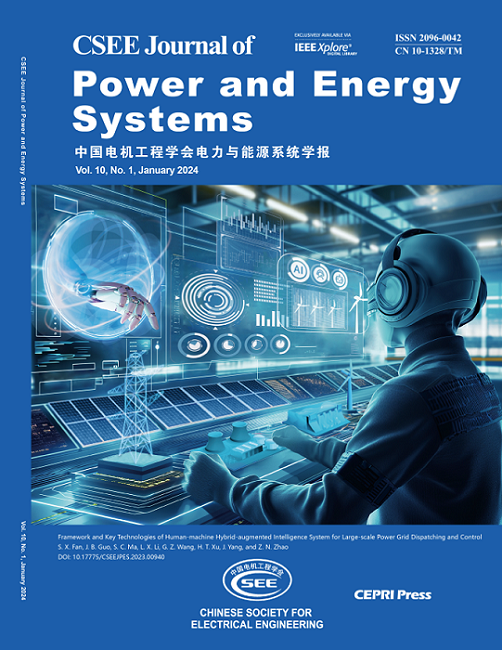Framework and Key Technologies of Human-machine Hybrid-augmented Intelligence System for Large-scale Power Grid Dispatching and Control
IF 5.9
2区 工程技术
Q2 ENERGY & FUELS
引用次数: 0
Abstract
With integration of large-scale renewable energy, new controllable devices, and required reinforcement of power grids, modern power systems have typical characteristics such as uncertainty, vulnerability and openness, which makes operation and control of power grids face severe security challenges. Application of artificial intelligence (AI) technologies represented by machine learning in power grid regulation is limited by reliability, interpretability and generalization ability of complex modeling. Mode of hybrid-augmented intelligence (HAI) based on human-machine collaboration (HMC) is a pivotal direction for future development of AI technology in this field. Based on characteristics of applications in power grid regulation, this paper discusses system architecture and key technologies of human-machine hybrid-augmented intelligence (HHI) system for large-scale power grid dispatching and control (PGDC). First, theory and application scenarios of HHI are introduced and analyzed; then physical and functional architectures of HHI system and human-machine collaborative regulation process are proposed. Key technologies are discussed to achieve a thorough integration of human/machine intelligence. Finally, state-of-the-art and future development of HHI in power grid regulation are summarized, aiming to efficiently improve the intelligent level of power grid regulation in a human-machine interactive and collaborative way.面向大规模电网调度与控制的人机混合增强智能系统框架与关键技术
随着大规模可再生能源、新型可控设备的集成以及电网需要加强,现代电力系统具有典型的不确定性、脆弱性和开放性等特征,使得电网运行与控制面临严峻的安全挑战。以机器学习为代表的人工智能(AI)技术在电网调控中的应用受限于复杂建模的可靠性、可解释性和泛化能力。基于人机协作(HMC)的混合增强智能(HAI)模式是该领域人工智能技术未来发展的重要方向。本文基于电网调控的应用特点,探讨了面向大规模电网调度控制(PGDC)的人机混合增强智能(HHI)系统的系统架构和关键技术。首先,介绍并分析了 HHI 的理论和应用场景,然后提出了 HHI 系统的物理和功能架构以及人机协同调节过程。讨论了实现人机智能全面融合的关键技术。最后,总结了 HHI 在电网调控中的应用现状和未来发展,旨在以人机交互协作的方式有效提高电网调控的智能化水平。
本文章由计算机程序翻译,如有差异,请以英文原文为准。
求助全文
约1分钟内获得全文
求助全文
来源期刊

CSEE Journal of Power and Energy Systems
Energy-Energy (all)
CiteScore
11.80
自引率
12.70%
发文量
389
审稿时长
26 weeks
期刊介绍:
The CSEE Journal of Power and Energy Systems (JPES) is an international bimonthly journal published by the Chinese Society for Electrical Engineering (CSEE) in collaboration with CEPRI (China Electric Power Research Institute) and IEEE (The Institute of Electrical and Electronics Engineers) Inc. Indexed by SCI, Scopus, INSPEC, CSAD (Chinese Science Abstracts Database), DOAJ, and ProQuest, it serves as a platform for reporting cutting-edge theories, methods, technologies, and applications shaping the development of power systems in energy transition. The journal offers authors an international platform to enhance the reach and impact of their contributions.
 求助内容:
求助内容: 应助结果提醒方式:
应助结果提醒方式:


